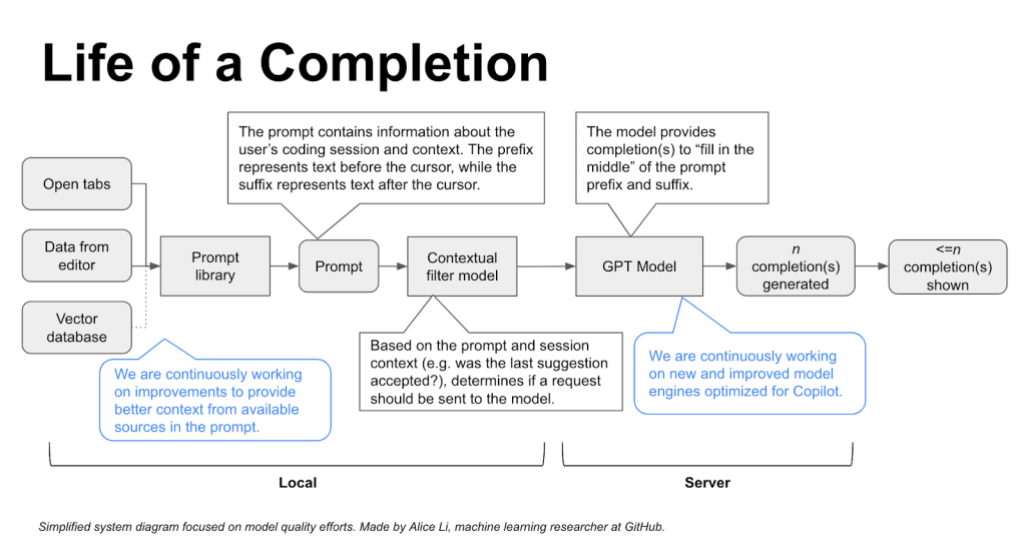How GitHub Copilot is getting better at understanding your code
With a new Fill-in-the-Middle paradigm, GitHub engineers improved the way GitHub Copilot contextualizes your code. By continuing to develop and test advanced retrieval algorithms, they’re working on making our AI tool even more advanced.

To make working with GitHub Copilot feel like a meeting of the minds between developers and the pair programmer, GitHub’s machine learning experts have been busy researching, developing, and testing new capabilities—and many are focused on improving the AI pair programmer’s contextual understanding. That’s because good communication is key to pair programming, and inferring context is critical to making good communication happen.
To pull back the curtain, we asked GitHub’s researchers and engineers about the work they’re doing to help GitHub Copilot improve its contextual understanding. Here’s what we discovered.
From OpenAI’s Codex model to GitHub Copilot
When OpenAI released GPT-3 in June 2020, GitHub knew developers would benefit from a product that leveraged the model specifically for coding. So, we gave input to OpenAI as it built Codex, a descendant of GPT-3 and the LLM that would power GitHub Copilot. The pair programmer launched as a technical preview in June 2021 and became generally available in June 2022 as the world’s first at-scale generative AI coding tool.
To ensure that the model has the best information to make the best predictions with speed, GitHub’s machine learning (ML) researchers have done a lot of work called prompt engineering (which we’ll explain in more detail below) so that the model provides contextually relevant responses with low latency.
Though GitHub’s always experimenting with new models as they come out, Codex was the first really powerful generative AI model that was available, said David Slater, a ML engineer at GitHub. “The hands-on experience we gained from iterating on model and prompt improvements was invaluable.”
All that experimentation resulted in a pair programmer that, ultimately, frees up a developer’s time to focus on more fulfilling work. The tool is often a huge help even for starting new projects or files from scratch because it scaffolds a starting point that developers can adapt and tweak as desired, said Alice Li, a ML researcher at GitHub.
I still find myself impressed and even surprised by what GitHub Copilot can do, even after having worked on it for some time now.
Why context matters
Developers use details from pull requests, a folder in a project, open issues, and more to contextualize their code. When it comes to a generative AI coding tool, we need to teach that tool what information to use to do the same.
Transformer LLMs are good at connecting the dots and big-picture thinking. Generative AI coding tools are made possible by large language models (LLMs). These models are sets of algorithms trained on large amounts of code and human language. Today’s state-of-the-art LLMs are transformers, which makes them adept at making connections between text in a user’s input and the output that the model has already generated. This is why today’s generative AI tools are providing responses that are more contextually relevant than previous AI models.
But they need to be told what information is relevant to your code. Right now, transformers that are fast enough to power GitHub Copilot can process about 6,000 characters at a time. While that’s been enough to advance and accelerate tasks like code completion and code change summarization, the limited amount of characters means that not all of a developer’s code can be used as context.
So, our challenge is to figure out not only what data to feed the model, but also how to best order and enter it to get the best suggestions for the developer.
| Learn more about LLMs, generative AI coding tools, and how they’re changing the way developers work. |
How GitHub Copilot understands your code
It all comes down to prompts, which are compilations of IDE code and relevant context that’s fed to the model. Prompts are generated by algorithms in the background, at any point in your coding. That’s why GitHub Copilot will generate coding suggestions whether you’re currently writing or just finished a comment, or in the middle of some gnarly code.
- Here’s how a prompt is created: a series of algorithms first select relevant code snippets or comments from your current file and other sources (which we’ll dive into below). These snippets and comments are then prioritized, filtered, and assembled into the final prompt.
GitHub Copilot’s contextual understanding has continuously matured over time. The first version was only able to consider the file you were working on in your IDE to be contextually relevant. But we knew context went beyond that. Now, just a year later, we’re experimenting with algorithms that will consider your entire codebase to generate customized suggestions.
Let’s look at how we got here:
- Prompt engineering is the delicate art of creating a prompt so that the model makes the most useful prediction for the user. The prompt tells LLMs, including GitHub Copilot, what data, and in what order, to process in order to contextualize your code. Most of this work takes place in what’s called a prompt library, which is where our in-house ML experts work with algorithms to extract and prioritize a variety of sources of information about the developer’s context, creating the prompt that’ll be processed by the GitHub Copilot model.
-
Neighboring tabs is what we call the technique that allows GitHub Copilot to process all of the files open in a developer’s IDE instead of just the single one the developer is working on. By opening all files relevant to their project, developers automatically invoke GitHub Copilot to comb through all of the data and find matching pieces of code between their open files and the code around their cursor—and add those matches to the prompt.
When developing neighboring tabs, the GitHub Next team and in-house ML researchers did A/B tests to figure out the best parameters for identifying matches between code in your IDE and code in your open tabs. They found that setting a very low bar for when to include a match actually made for the best coding suggestions.
By including every little bit of context, neighboring tabs helped to relatively increase user acceptance of GitHub Copilot’s suggestions by 5%**.
Even if there was no perfect match—or even a very good one—picking the best match we found and including that as context for the model was better than including nothing at all.
- The Fill-In-the-Middle (FIM) paradigm widened the context aperture even more. Prior to FIM, only the code before your cursor would be put into the prompt—ignoring the code after your cursor. (At GitHub, we refer to code before the cursor as the prefix and after the cursor as the suffix.) With FIM, we can tell the model which part of the prompt is the prefix, and which part is the suffix.
Even if you’re creating something from scratch and have a skeleton of a file, we know that coding isn’t linear or sequential. So, while you bounce around your file, FIM helps GitHub Copilot offer better coding suggestions for the part in your file where your cursor is located, or the code that’s supposed to come between the prefix and suffix.
Based on A/B testing, FIM gave a 10% relative boost in performance, meaning developers accepted 10% more of the completions that were shown to them. And thanks to optimal use of caching, neighboring tabs and FIM work in the background without any added latency.

Improving semantic understanding
Today, we’re experimenting with vector databases that could create a customized coding experience for developers working in private repositories or with proprietary code. Generative AI coding tools use something called embeddings to retrieve information from a vector database.
- What’s a vector database? It’s a database that indexes high-dimensional vectors.
-
What’s a high-dimensional vector? They’re mathematical representations of objects, and because these vectors can model objects in a number of dimensions, they can capture complexities of that object. When used properly to represent pieces of code, they may represent both the semantics and even intention of the code—not just the syntax.
-
What’s an embedding? In the context of coding and LLMs, an embedding is the representation of a piece of code as a high-dimensional vector. Because of the “knowledge” the LLM has of both programming and natural language, it’s able to capture both the syntax and semantics of the code in the vector.
Here’s how they’d all work together:
- Algorithms would create embeddings for all snippets in the repository (potentially billions of them), and keep them stored in the vector database.
- Then, as you’re coding, algorithms would embed the snippets in your IDE.
- Algorithms would then make approximate matches—also, in real time—between the embeddings that are created for your IDE snippets and the embeddings already stored in the vector database. The vector database is what allows algorithms to quickly search for approximate matches (not just exact ones) on the vectors it stores, even if it’s storing billions of embedded code snippets.
Developers are familiar with retrieving data with hashcodes, which typically look for exact character by character matches, explained Alireza Goudarzi, senior ML researcher at GitHub. “But embeddings—because they arise from LLMs that were trained on a vast amount of data—develop a sense of semantic closeness between code snippets and natural language prompts.”
Read the three sentences below and identify which two are the most semantically similar.
- Sentence A: The king moved and captured the pawn.
- Sentence B: The king was crowned in Westminster Abbey.
- Sentence C: Both white rooks were still in the game.
The answer is sentences A and C because both are about chess. While sentences A and B are syntactically, or structurally similar because both have a king as the subject, they’re semantically different because “king” is used in different contexts.
Here’s how each of those statements could translate to Python. Note the syntactic similarity between snippets A and B despite their semantic difference, and the semantic similarity between snippets A and C despite their syntactic difference.
Snippet A:
if king.location() == pawn.location():
board.captures_piece(king, pawn)
Snippet B:
if king.location() == "Westminster Abbey":
king.crown()
Snippet C:
if len([ r for r in board.pieces("white") if r.type == "rook" ]) == 2:
return True
As mentioned above, we’re still experimenting with retrieval algorithms. We’re designing the feature with enterprise customers in mind, specifically those who are looking for a customized coding experience with private repositories and would explicitly opt in to use the feature.
Take this with you
Last year, we conducted quantitative research on GitHub Copilot and found that developers code up to 55% faster while using the pair programmer. This means developers feel more productive, complete repetitive tasks more quickly, and can focus more on satisfying work. But our work won’t stop there.
The GitHub product and R&D teams, including GitHub Next, have been collaborating with Microsoft Azure AI-Platform to continue bringing improvements to GitHub Copilot’s contextual understanding. So much of the work that helps GitHub Copilot contextualize your code happens behind the scenes. While you write and edit your code, GitHub Copilot is responding to your writing and edits in real time by generating prompts–or, in other words, prioritizing and sending relevant information to the model based on your actions in your IDE—to keep giving you the best coding suggestions.
Learn more
- GitHub Copilot X is our envisioned future of AI-powered software development. Discover what’s new.
- Learn how the LLMs powering GitHub Copilot are getting better.
- Read our research on how GitHub Copilot is impacting developer productivity.
Tags:
Written by
Related posts

For the Love of Code: a summer hackathon for joyful, ridiculous, and wildly creative projects
That idea you’ve been sitting on? The domain you bought at 2AM? A silly or serious side project? This summer, we invite you to build it — for the joy, for the vibes, For the Love of Code 🧡

From chaos to clarity: Using GitHub Copilot agents to improve developer workflows
Explore how you can set Copilot coding agent up for success with custom instruction and Copilot setup steps.

Code review in the age of AI: Why developers will always own the merge button
When it comes to merging code, developers will always make the final decision. But we’re rethinking how tools like GitHub Copilot can help.
